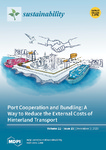Visitor Management in World Heritage Destinations before and after Covid-19, Angkor

Ver/
Use este enlace para citar
http://hdl.handle.net/2183/27150Coleccións
- Investigación (FSOC) [405]
Metadatos
Mostrar o rexistro completo do ítemTítulo
Visitor Management in World Heritage Destinations before and after Covid-19, AngkorData
2020Cita bibliográfica
Alvarez-Sousa, A.; Paniza Prados, J.L. Visitor Management in World Heritage Destinations before and after Covid-19, Angkor. Sustainability 2020, 12, 9929.
Resumo
[Abstract] The purpose of this research was to analyze the visitor-management tactics and strategies in World Heritage destinations. The Temples of Angkor (Cambodia) were selected as case studies. The analysiswas carried out in two phases—before and after COVID-19. A qualitativemethodologywas used. Participant observation was employed for the pre-COVID-19 strategies, and recommendations of scholars and bodies responsible for tourism were the basis for the strategies proposed for the post-COVID-19 scenario. Grounded theory and the Atlas.ti qualitative analysis software were used. The results showed that the public health goal, together with its related strategies and tactics, should be added to the classic sustainability goals and the hard and soft strategies (physical, regulatory, and educational). It was also noted that new actors came into play—those responsible for public health.
In conclusion, this new public health goal and its tactics will condition classic factors such as carrying capacity, and can conflict with goals such as the economic and social goals. The sustainability paradigm is maintained, but with the addition of risk society and the public health goal playing a key role.
Palabras chave
Visitor management
Angkor
COVID-19
Risk society
Carrying capacity
Social distancing
Public health
Sustainable development
Angkor
COVID-19
Risk society
Carrying capacity
Social distancing
Public health
Sustainable development
Versión do editor
Dereitos
Atribución 3.0 España
ISSN
2071-1050






